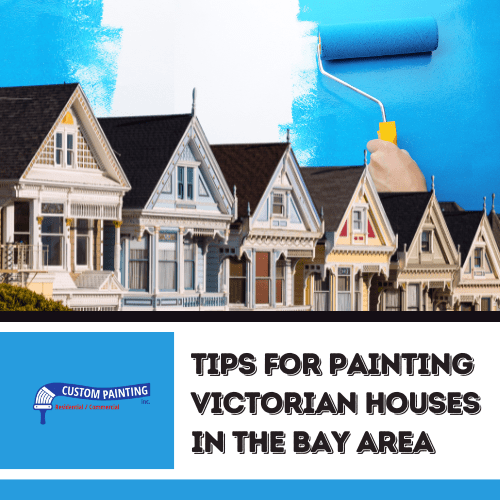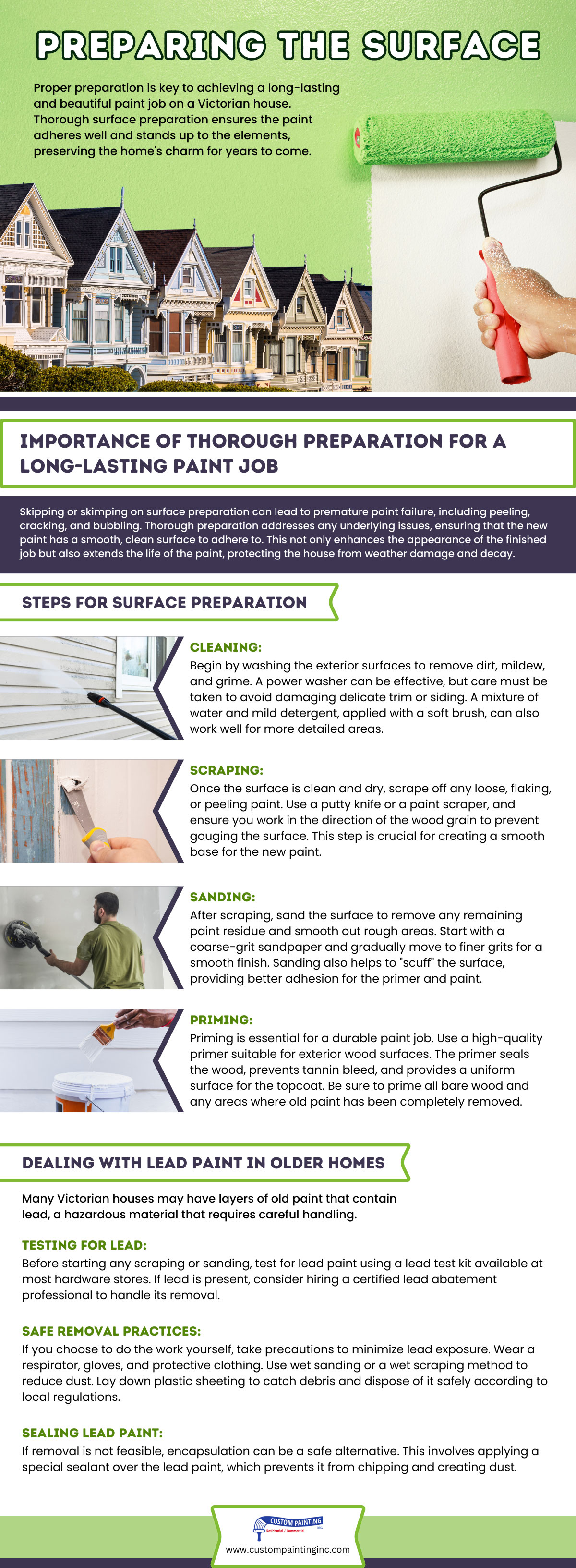Victorian houses in the Bay Area are a beautiful testament to the area’s history. They feature intricate designs and vibrant colors that tell stories of the past eras. These architectural gems need regular maintenance and fresh coats of paint to retain their charm. If you are one of those who own a Victorian house and are looking for ways to maintain its beauty, we are here to help you. This article offers practical tips for painting Victorian houses, helping homeowners preserve their beauty and historical significance.
Understanding Victorian Architecture
Victorian architecture is a testament to the grandeur and elegance of a bygone era. Known for its intricate details and unique design elements, these homes are architectural masterpieces that stand out in the modern landscape.
Common Architectural Features of Victorian Houses
Victorian houses are characterized by several distinct features that set them apart from other styles:
- Steeply Pitched Roofs: These roofs often have intricate designs, including gables and dormers.
- Ornate Trim: Also known as “gingerbread” trim, these decorative woodwork details add a touch of elegance.
- Bay Windows: Prominent and often curved, these windows provide expansive views and add dimension to the facade.
- Asymmetrical Facades: Unlike the balanced symmetry of earlier architectural styles, Victorian homes often have irregular, yet harmonious, shapes.
Different Styles within the Victorian Era
The Victorian era encompassed several architectural styles, each with its unique features:
Queen Anne: The Queen Anne style is perhaps the most recognizable of all Victorian designs. It features a variety of textures and materials, including wood and brick, and often boasts elaborate gables, wrap-around porches, and turrets. The eclectic mix of elements gives each Queen Anne home a unique, whimsical appearance.
Gothic Revival: Inspired by medieval European architecture, Gothic Revival homes are distinguished by their pointed arches, steeply pitched roofs, and intricate wooden trim. These houses often evoke a sense of grandeur and mystery reminiscent of ancient cathedrals.
Italianate: Italianate houses are characterized by their tall, narrow windows, often rounded or arched, and wide eaves supported by decorative brackets. These homes sometimes include a cupola or tower, adding to their stately and picturesque appearance.
Importance of Preserving Architectural Integrity While Painting
When it comes to painting Victorian houses, preserving their architectural integrity is paramount. The right color palette can enhance the home’s intricate details and highlight its historical significance. Choosing colors that reflect the era’s authentic shades and patterns helps maintain the home’s original charm and character including in many cases spectacular and elegant crown moulding.
Additionally, it’s essential to use high-quality materials and techniques to protect the house’s structure and delicate woodwork. Proper preparation and application ensure that the paint job will last, safeguarding the home’s beauty and historical value for years to come. By respecting and preserving these architectural treasures, we honor the craftsmanship and artistry of the Victorian era.
Choosing the Right Colors
Selecting the right colors for a Victorian house is a crucial step in maintaining its historical charm and enhancing its visual appeal. Understanding historical color palettes and considering contemporary preferences can help homeowners make informed decisions.
Historical Color Palettes Used in Victorian Times
During the Victorian era, color choices were often bold and rich, reflecting the period’s ornate and decorative style. Popular colors included:
- Earthy Tones: Deep reds, browns, and greens were commonly used to blend with natural surroundings.
- Muted Shades: Soft, muted tones like sage green, dusty rose, and lavender provided a refined elegance.
- Contrasting Trim: Bright colors like white, cream, or gold were used for trim to create striking contrasts against darker base colors.
These historical palettes were chosen not only for their aesthetic appeal but also for their durability and ability to enhance architectural details.
Popular Color Schemes for Victorian Houses in the Bay Area
In the Bay Area, Victorian houses often feature vibrant and diverse color schemes that reflect both historical influences and modern tastes. Popular choices include:
- Bright and Bold Combinations: Turquoise, salmon pink, and mustard yellow are often seen, creating a lively and cheerful appearance.
- Soft Pastels: Light blues, mint greens, and pale yellows offer a more subdued yet equally charming look.
- Monochromatic Themes: Using varying shades of a single color, such as different blues or greens, can create a cohesive and elegant appearance.
These schemes highlight the intricate details of Victorian architecture while blending harmoniously with the region’s unique character.
Considerations for Selecting Colors That Complement the House and Its Surroundings
When choosing colors for a Victorian house, several factors should be considered to ensure the selected palette complements both the house and its environment:
- Architectural Features: Highlighting specific architectural elements with contrasting or complementary colors can enhance the house’s unique features.
- Neighborhood Aesthetics: Consider the color schemes of neighboring houses to ensure a cohesive and harmonious streetscape.
- Natural Surroundings: Choose colors that blend well with the natural landscape, such as earthy tones for wooded areas or brighter shades for urban settings.
- Historical Accuracy: While modern preferences are important, incorporating historically accurate colors can help maintain the home’s authenticity and heritage.
By thoughtfully selecting colors that reflect both the historical significance and contemporary appeal, homeowners can enhance the beauty and charm of their Victorian houses, ensuring these architectural treasures remain timeless and captivating.
Preparing the Surface
Proper preparation is key to achieving a long-lasting and beautiful paint job on a Victorian house. Thorough surface preparation ensures the paint adheres well and stands up to the elements, preserving the home’s charm for years to come.
Importance of Thorough Preparation for a Long-Lasting Paint Job
Skipping or skimping on surface preparation can lead to premature paint failure, including peeling, cracking, and bubbling. Thorough preparation addresses any underlying issues, ensuring that the new paint has a smooth, clean surface to adhere to. This not only enhances the appearance of the finished job but also extends the life of the paint, protecting the house from weather damage and decay.
Steps for Surface Preparation
- Cleaning: Begin by washing the exterior surfaces to remove dirt, mildew, and grime. A power washer can be effective, but care must be taken to avoid damaging delicate trim or siding. A mixture of water and mild detergent, applied with a soft brush, can also work well for more detailed areas.
- Scraping: Once the surface is clean and dry, scrape off any loose, flaking, or peeling paint. Use a putty knife or a paint scraper, and ensure you work in the direction of the wood grain to prevent gouging the surface. This step is crucial for creating a smooth base for the new paint.
- Sanding: After scraping, sand the surface to remove any remaining paint residue and smooth out rough areas. Start with a coarse-grit sandpaper and gradually move to finer grits for a smooth finish. Sanding also helps to “scuff” the surface, providing better adhesion for the primer and paint.
- Priming: Priming is essential for a durable paint job. Use a high-quality primer suitable for exterior wood surfaces. The primer seals the wood, prevents tannin bleed, and provides a uniform surface for the topcoat. Be sure to prime all bare wood and any areas where old paint has been completely removed.
Dealing with Lead Paint in Older Homes
Many Victorian houses may have layers of old paint that contain lead, a hazardous material that requires careful handling.
- Testing for Lead: Before starting any scraping or sanding, test for lead paint using a lead test kit available at most hardware stores. If lead is present, consider hiring a certified lead abatement professional to handle its removal.
- Safe Removal Practices: If you choose to do the work yourself, take precautions to minimize lead exposure. Wear a respirator, gloves, and protective clothing. Use wet sanding or a wet scraping method to reduce dust. Lay down plastic sheeting to catch debris and dispose of it safely according to local regulations.
- Sealing Lead Paint: If removal is not feasible, encapsulation can be a safe alternative. This involves applying a special sealant over the lead paint, which prevents it from chipping and creating dust.
By following these steps and addressing any potential lead paint hazards, you can ensure that your Victorian house is well-prepared for a new coat of paint. This careful preparation not only enhances the final appearance but also protects the integrity of your historic home.
Selecting the Right Paint
Choosing the right paint for the exterior of your Victorian house is crucial for maintaining its beauty and protecting it from the elements. The Bay Area’s unique climate requires specific types of paint to ensure durability and longevity.
Types of Paint Suitable for Exterior Use in the Bay Area Climate
The Bay Area experiences a mix of coastal fog, sun, and occasional rain, which can take a toll on exterior paint. Here are the types of paint that are best suited for this climate:
- Acrylic Latex Paint: This is a popular choice for exterior surfaces due to its durability and flexibility. Acrylic latex paint is resistant to cracking and peeling, which is essential in an area with fluctuating temperatures and moisture levels.
- Elastomeric Paint: Known for its excellent adhesion and flexibility, elastomeric paint can expand and contract with the wood, making it ideal for older Victorian homes that may have slight shifts over time.
- Oil-Based Paint: While less common now due to environmental concerns, oil-based paint offers excellent adhesion and durability. It is particularly good for areas that experience heavy wear and tear, such as trims and doors.
Benefits of Using High-Quality, Durable Paint
Investing in high-quality paint offers several benefits:
- Longevity: High-quality paint lasts longer, reducing the frequency of repainting and saving time and money in the long run.
- Protection: Superior paint provides better protection against the elements, including UV rays, moisture, and mildew. This is particularly important in the Bay Area, where weather conditions can vary widely.
- Aesthetics: Premium paint tends to have richer pigments and a more consistent finish, enhancing the visual appeal of your Victorian house.
- Ease of Application: High-quality paint often goes on smoother and requires fewer coats, making the painting process more efficient.
Considerations for Eco-Friendly and Low-VOC Paint Options
Environmental impact and indoor air quality are important considerations when selecting paint. Eco-friendly and low-VOC (volatile organic compounds) paints offer several advantages:
- Low-VOC Paint: These paints emit fewer harmful chemicals, improving indoor air quality and reducing health risks. They are especially beneficial for homes with children, elderly residents, or individuals with respiratory issues.
- Eco-Friendly Paint: Made from natural ingredients and free from harmful chemicals, eco-friendly paints are better for the environment. They often use sustainable materials and production processes, reducing their carbon footprint.
- Performance: Modern low-VOC and eco-friendly paints offer comparable durability and performance to traditional paints. Advances in technology have improved their adhesion, coverage, and resistance to weathering.
When selecting paint, look for products certified by organizations like Green Seal or the EPA’s Safer Choice program. These certifications ensure that the paint meets rigorous environmental and safety standards.
Techniques for Painting Victorian Details
Painting the intricate trim and decorative features of a Victorian house requires special tools and techniques. Attention to detail is essential to highlight the architectural beauty and ensure a professional finish.
Tools and Techniques for Painting Intricate Trim and Decorative Features
Victorian houses often feature complex woodwork, such as gingerbread trim, brackets, and corbels. To paint these details effectively, the right tools and techniques are essential:
- Small Brushes: Use fine, high-quality brushes, such as artist’s brushes or small angled brushes, for detailed work. These allow for precise control over small areas and intricate designs.
- Detail Rollers: Miniature rollers with soft, high-density foam are ideal for painting narrow, flat surfaces quickly and evenly.
- Painter’s Tape: Applying painter’s tape to adjacent surfaces helps protect them and ensures clean edges where different colors meet.
- Spray Guns: For large areas with intricate designs, a paint sprayer can provide a smooth, even coat. However, careful masking and practice are required to avoid overspray.
Tips for Achieving Clean Lines and Crisp Details
To achieve clean lines and crisp details, follow these tips:
- Preparation: Thoroughly clean and sand the surfaces to ensure the paint adheres properly. Remove any loose or flaking paint.
- Priming: Use a high-quality primer on bare wood and previously painted surfaces. Priming helps the paint adhere better and provides a uniform base color.
- Steady Hand: Practice a steady hand technique by resting your arm on a stable surface and using your wrist for small, controlled movements.
- Layering: Apply multiple thin layers of paint rather than one thick layer. Thin layers dry more evenly and reduce the risk of drips and runs.
- Painter’s Tape: For sharp lines, apply painter’s tape and press it down firmly to prevent paint from bleeding underneath. Remove the tape while the paint is still slightly wet to avoid peeling.
Importance of Using Appropriate Brushes and Tools for Different Surfaces
Using the right brushes and tools for different surfaces ensures a smooth, professional finish:
- Flat Surfaces: Use wider, flat brushes or rollers for large, flat areas. These tools cover more surface area quickly and evenly.
- Corners and Edges: Angled brushes are ideal for painting corners, edges, and trim. Their shape allows for precise application and access to tight spaces.
- Intricate Details: Small, fine-tip brushes are essential for painting detailed woodwork, such as scrollwork and moldings. These brushes provide control and precision.
- Textured Surfaces: For textured surfaces, such as stucco or rough wood, use brushes with stiff bristles or high-density foam rollers to ensure the paint penetrates the texture.
By using the appropriate tools and techniques, you can achieve a professional-quality paint job that enhances the intricate details and unique character of your Victorian house. Careful attention to preparation, steady application, and the right equipment will ensure that every detail is beautifully highlighted and preserved.
Addressing Common Challenges
Painting a Victorian house in the Bay Area presents unique challenges, from dealing with specific weather conditions to managing time and labor for large projects. Deciding between hiring professional painters and taking on a DIY project also requires careful consideration.
Dealing with the Bay Area’s Weather Conditions
The Bay Area’s climate, characterized by fog, moisture, and temperature fluctuations, can affect the painting process and the longevity of the paint job:
- Fog and Moisture: High humidity and frequent fog can delay drying times and cause paint to blister or peel. To combat this, choose paints specifically formulated for humid climates and schedule painting during drier periods.
- Temperature Fluctuations: The Bay Area can experience significant temperature swings between day and night. This can cause paint to expand and contract, leading to cracks and peeling. Using high-quality, flexible paints like acrylic latex or elastomeric paints can help accommodate these changes.
- Timing: Plan your painting project during the late spring or early fall when the weather is typically more stable. Avoid painting during the rainy season or when fog is prevalent.
Managing Time and Labor for Large or Multi-Story Victorian Houses
Victorian houses are often large and multi-storied, requiring significant time and effort to paint:
- Planning: Break down the project into manageable sections, focusing on one area at a time. This approach helps maintain momentum and makes the task less overwhelming.
- Scaffolding: For multi-story houses, use scaffolding to safely access higher areas. Scaffolding provides a stable platform, reducing the risk of accidents and making the job easier.
- Teamwork: If you’re painting with a team, assign specific tasks to each member. For example, one person can handle scraping and sanding, while another focuses on priming and painting. This division of labor increases efficiency.
- Pacing: Allow sufficient time for each step of the process, including preparation, priming, painting, and drying. Rushing can compromise the quality of the work and lead to mistakes.
Hiring Professional Painters vs. DIY: Pros and Cons
Deciding whether to hire professional painters or take on the project yourself depends on various factors, including budget, skill level, and time availability.
Hiring Professional Painters:
Pros:
- Expertise: Professional painters have the skills and experience to handle complex projects, ensuring a high-quality finish.
- Efficiency: Professionals can complete the job more quickly than most DIY efforts, thanks to their experience and access to better tools and equipment.
- Safety: Painting multi-story houses can be dangerous. Professionals are trained in safe practices and have the necessary equipment to work safely at heights.
- Warranty: Many professional painters offer warranties on their work, providing peace of mind and assurance of quality.
Cons:
- Cost: Hiring professionals can be expensive, especially for large houses with intricate details.
- Scheduling: You may need to work around the painter’s schedule, which could delay your project.
DIY Painting:
Pros:
- Cost Savings: Doing the work yourself can save money, as you only need to purchase materials and basic tools.
- Personal Satisfaction: Completing the project yourself can be rewarding and give you a sense of accomplishment.
- Control: You have complete control over the project, from color selection to the pace of work.
Cons:
- Time-Consuming: Painting a large Victorian house is a time-intensive project that may take weeks or even months to complete.
- Skill Level: Achieving a professional finish requires skill and experience. Mistakes can be costly and time-consuming to fix.
- Physical Demands: Painting can be physically demanding, especially when working on high ladders or scaffolding.
Maintenance and Upkeep
Routine maintenance and careful upkeep are essential to extend the life of the paint job on your Victorian house. Regular attention helps preserve the beauty and integrity of the paint, ensuring your home continues to look its best.
Routine Maintenance to Extend the Life of the Paint Job
To keep your paint job looking fresh and vibrant, incorporate these routine maintenance tasks into your schedule:
- Regular Cleaning: Wash the exterior surfaces at least once a year to remove dirt, mildew, and pollutants. Use a mild detergent and a soft brush or a low-pressure power washer to avoid damaging the paint.
- Inspection: Conduct a thorough inspection of the painted surfaces twice a year, preferably in spring and fall. Look for signs of wear and tear, such as peeling, cracking, or blistering.
- Gutter Maintenance: Keep gutters and downspouts clean and in good repair. Properly functioning gutters prevent water from running down the sides of the house, which can lead to paint damage and wood rot.
- Trimming Vegetation: Ensure that trees, shrubs, and vines are trimmed back from the house. Vegetation can trap moisture against the paint and cause damage over time.
Identifying and Addressing Potential Issues Early
Early detection and prompt action can prevent minor issues from becoming major problems:
- Peeling and Cracking: If you notice peeling or cracking paint, scrape off the loose paint, sand the area smooth, and apply primer and a fresh coat of paint. Addressing these issues early prevents further deterioration.
- Blistering: Blisters or bubbles in the paint can indicate moisture problems. Identify and fix the source of moisture, then sand and repaint the affected areas.
- Mildew and Mold: Mildew and mold growth appear as dark, discolored spots on the paint. Clean these areas with a mixture of water and bleach, then rinse thoroughly. Repaint if necessary to prevent regrowth.
- Wood Rot: If you discover rotting wood, replace the damaged sections and repaint. Ensuring proper ventilation and sealing can help prevent future rot.
Tips for Touch-Ups and Ongoing Care
Regular touch-ups and ongoing care can keep your paint job looking pristine:
- Keep Extra Paint: Store leftover paint in a cool, dry place for future touch-ups. Label the cans with the date and location of use to make matching colors easier.
- Touch-Up Kit: Assemble a touch-up kit with small brushes, painter’s tape, sandpaper, and primer. This kit allows you to quickly address minor issues as they arise.
- Feathering Technique: When touching up, use the feathering technique to blend the new paint with the existing paint. Apply the paint in thin layers, gradually extending beyond the damaged area to create a seamless transition.
- Seasonal Touch-Ups: Perform minor touch-ups seasonally, particularly after harsh weather conditions. This proactive approach helps maintain the overall appearance and prevents small issues from escalating.
- Regular Maintenance Schedule: Establish a regular maintenance schedule that includes cleaning, inspecting, and performing touch-ups. Consistency in maintenance ensures the longevity of the paint job and keeps your Victorian house looking its best.
By incorporating these maintenance and upkeep practices, you can extend the life of your paint job, preserve the beauty of your Victorian house, and protect your investment for years to come.
Conclusion
Painting and maintaining a Victorian house in the Bay Area requires attention to detail and the right techniques. By following these tips, you can preserve the beauty and integrity of your historic home. For professional assistance, contact Custom Painting, Inc. at 925-294-8062 or fill out the contact form.







